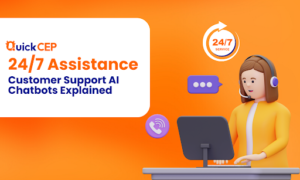For many years, chatbots reigned as the leading tools for automated customer service. Their pre-programmed scripts and canned responses enable seamless and prompt 24/7 assistance without human involvement.
Industries aiming to keep pace started to provide AI-powered, automated customer service with generative AI coming into the mainstream. Eventually, conversational AI dialed up businesses’ support service, providing personalized and contextually relevant responses to customers.
Yet, many are still confused about the difference between a chatbot and a conversational AI. They’re both capable of “talking” with customers and appear almost identical in chat widgets. But how are they different?
Let’s talk about chatbot vs conversational AI and see which one perfectly fits your business needs.
What Are Chatbots?
Chatbots are computer programs developed to carry out textual conversations with humans.
The simplest type of chatbots is the old-school, rule-based ones. They follow a predefined set of rules or decision-tree workflow to address a user inquiry.

Rule-based chatbots can perform simple and repetitive support tasks like answering FAQs, tracking order status, or scheduling appointments. However, they cannot understand the conversation context or engage in complex topics beyond their programmed knowledge.
Recently, artificial intelligence enhanced chatbots’ ability to understand customers’ intent and provide more nuanced and helpful responses.
See how QuickCEP’s chatbots recognize customers’ intent to provide stellar automated support when you sign up for FREE.
You can try and simulate conversations from QuickCEP chatbots through programmed knowledge and using Natural Language Processing (NLP). With this approach, QuickCEP’s chatbots can understand context and intent, unlike traditional chatbots.
Chatbot Use Cases In Customer Service
Here are some applications of chatbots in customer service.
Frequently Asked Questions (FAQs)
Chatbots can address simple customer inquiries around the clock. If a site visitor asks about your new products’ specifications, it can instantly provide a helpful response based on your knowledge base.
Appointment Scheduling
If a customer desires to have a one-on-one appointment with a sales or support rep, they can “talk” to the chatbot to book a schedule. Instead of completing appointment forms, the chatbot can simply ask for their preferred date, time, and communication channel.
Order Status Updates
A customer recently purchased from your online store. You tell her that the package might take several days to arrive. If she wants some real-time updates about her order shipping, she can send the order’s ID number to the chatbot to check its expected arrival time and shipping status.
Automated Support
Using canned and scripted responses, chatbots can automatically provide first-level assistance to customers. They can provide step-by-step guides for simple customer concerns like product onboarding, troubleshooting, or replacement. They can also point customers to your self-service content and resources.
What Is A Conversational AI?
Conversational AI is an umbrella term for technologies that apply machine learning to learn from data and natural language processing (NLP) to comprehend and engage in human conversations.
Simply put, conversational AI enables computers to mimic person-to-person conversations.

In customer support, conversational AI is useful in developing conversational chatbots and assistants. Think of it as a special upgrade to level-up chatbots’ capability to engage in more personalized and interactive conversations.
Consider QuickCEP’s conversational AI chatbot. Notice how it addresses a customer refund request. Instead of simply echoing the refund guide in your handbook, it engages the customer through human-like conversations as if it understands the customer’s sentiments and emotions.
Afterward, it provides personalized and helpful support that improves the overall customer experience.
Conversational AI Use Cases In Customer Service
Common applications of conversational AI in customer service are:
Personalized Product Recommendations
Suppose a customer asks for a product perfect for her new remote office. Conversational AI can analyze her unique preferences and interests to provide tailored-fit product suggestions
Natural Language Understanding
When conversational AI “talks” with a customer, it understands the language nuances and complexities to provide an accurate response. For instance, conversational AI can detect a user’s confusion about your new product based on his inputs, allowing it to provide detailed explanations to clarify the matter.

Resolution of Complex Concerns
Conversational AI can think of solutions for “out-of-the-box” scenarios. Suppose a customer encountered a product issue but was unsure what exactly the problem was. Based on the details provided, the conversational AI can make inferences on how to resolve the issue.
Emotional Support and Empathy
Conversational AI can converse with empathy as it “detects” emotions from customers’ requests allowing it to generate assuring and empathic responses to customer problems.
Key Differences of Chatbots vs Conversational AI In Customer Service
| Chatbot | Conversational AI | |
|---|---|---|
| Functionality | Prompt and accurate responses | Personalized and contextually relevant support services. |
| Capabilities | Incapable of comprehending conversation context; perform tasks within its pre-defined programmed rules only. | Advanced understanding of language nuances and complexities; engages in more open-ended, complex, and human-like communications. |
| User Experience | Static and linear customer interaction. | Dynamic and interactive conversations. |
| Development | Involves a time-consuming coding process. | Fast and code-free development process. |
| Maintenance Costs | Tedious and high-cost manual updating of coding architecture. | Simple maintenance process by updating the business's database and program interface. |
| Adaptability | Poor flexibility because chatbots operate only within its decision-tree workflow or script. | Flexible to “out-of-script” commands and prompts, capable of adapting to fluid interactions. |
| Scalability | Hard to scale due to its underlying coding architecture. | Easily scalable as it adapts to new and complex prompts. |
- Functionality: Chatbots are oriented to solve problems as quickly as possible. Meanwhile, Conversational AI also prioritizes a positive and convenient customer experience.
- Capabilities: Chatbots cannot understand conversation context or intent. They only match keywords in the input to their script to generate responses. Meanwhile, conversational AI can detect intent and sentiment, allowing it to engage in an intelligent, human-like interaction.
- User-Experience: Chatbots interact linearly since they strictly follow a conversation flow to operate. In contrast, conversational AI is highly interactive, two-way, and dynamic.
- Development: It’s not a cakewalk to develop chatbots as it requires high-level coding expertise and weeks of preparation. Meanwhile, conversational AI can be trained in minutes by simply importing internal content or adding web pages. Maintenance costs: It is costly to hire a coding professional for the manual maintenance of chatbots. Whereas conversational AI maintenance only needs reupdating of its training data.
- Adaptability: Rule-based chatbots are inflexible as their operations are constrained by their underlying scripts or rules. Meanwhile, conversational AI can adapt to complex and fluid scenarios due to its ability to comprehend conversation context. Scalability: Both are scalable to meet increasing support demands. However, conversational AI is easier to scale because it doesn’t require technical coding to scale service to more customers.
How QuickCEP Helps You With Chatbots and Conversational AI
QuickCEP is one of the best chatbot platforms for creating chatbots and conversational AI to enhance customer support. You can deploy these AI chatbots to your website to provide personalized, efficient, around-the-clock assistance.
Not a coding pro? Fret not. Simply add your internal help docs or URLs and let the chatbot learn your content. Upon training, the QuickCEP AI chatbot can perform automated support, product recommendations, order tracking, intent analysis, and after-sales support in over 50 languages.
With its playground feature, you can test and fine-tune your AI chatbot’s performance and customize its responses.

You can also manage the bot knowledge base to keep your chatbot’s responses accurate and up-to-date.

So Which Is Better For Your Business: Chatbots vs Conversational AI?
Why pick one if you can leverage them both? As more customers demand fast and seamless support service, using a hybrid approach is the wisest choice—standardized scripted responses improved with increased personalization and flexibility.
QuickCEP offers an effective blend of chatbots and conversational AI to empower your support agents. Try our AI chatbot features today for free.



